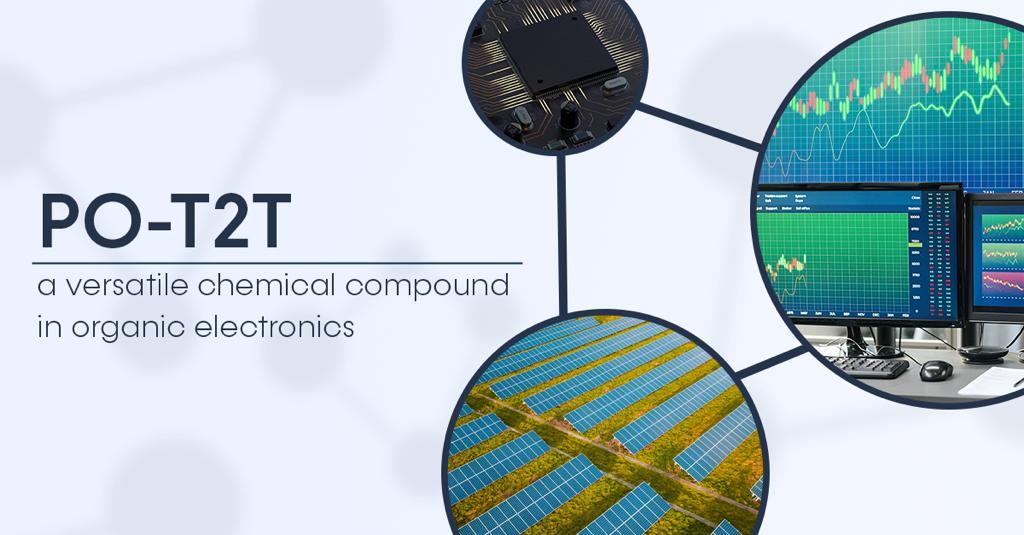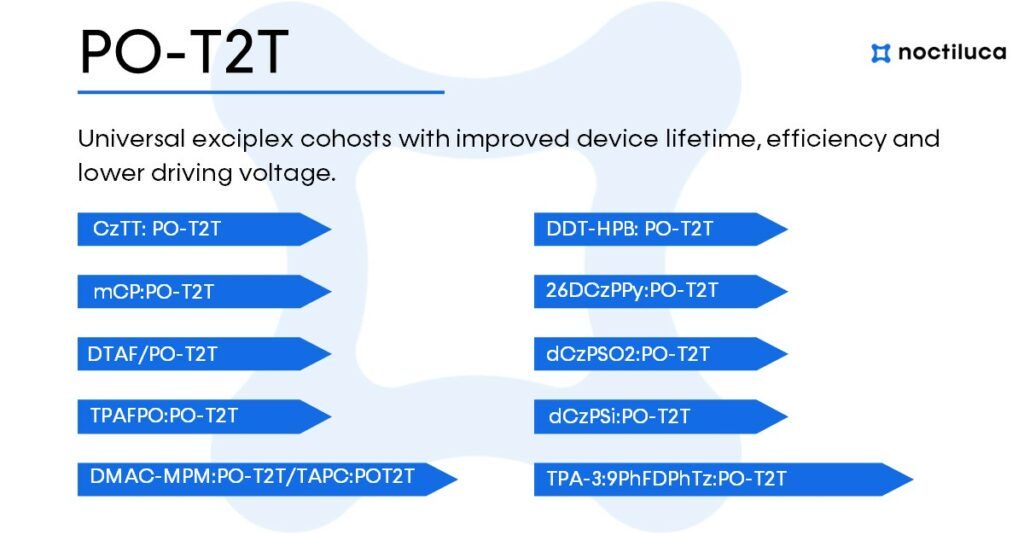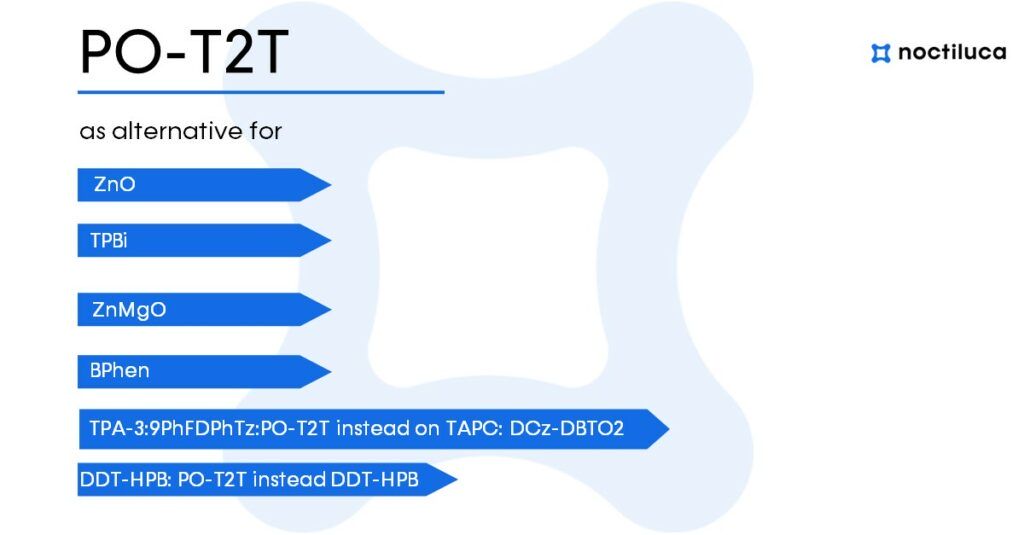January 2024
Blog post by Dominika Gonet, Noctiluca
PO-T2T, widely recognized for its important role in organic electronics, has become a preferred choice as an electron transport/hole blocking material and electron acceptor in various applications. Its popularity stems from its role as a host and exciplex-forming material in TADF OLEDs (thermally activated delayed fluorescence organic light-emitting diodes). Additionally, owing to its electron-deficient nature, it serves as a crucial component in electron transport layers (ETL), contributing to improved OLED performance metrics such as device lifetime and lower driving voltage. Explore the diverse applications and advantages of PO-T2T, and its role in the development of organic electronics.

Key adventages of PO-T2T in various applications
1. Improved device performance: When combined with other electron-donating materials, PO-T2T enhances device lifetime, efficiency, and lowers driving voltage, making it a preferred choice for various device architectures.
2. Exceptional thermal stability: With a high decomposition temperature of 460°C, PO-T2T exhibits excellent thermal stability, ensuring reliable performance in demanding conditions.
3. Enhanced electron transport ability: PO-T2T improves the electron transport ability of ETLs, leading to better band alignment and increased external quantum efficiency (EQE) in OLEDs.
4. Versatility in device architectures: PO-T2T’s versatility allows for its use in different device architectures, offering flexibility in energy level alignments in heterojunctions.
5. Stable operation at elevated current densities: PO-T2T-based devices demonstrate the highest stable operation at elevated current densities, contributing to their robust performance.
6. Improved EQE: Deeper highest occupied molecular orbital (HOMO) and higher T1 energy levels of PO-T2T result in approximately 20% improvement in EQE for PO-T2T-based devices.
PO-T2T in OLED stacks, perovskite-based devices and emerging semiconductor devices
In OLED production, PO-T2T can be used in both Physical Vapor Deposition (PVD) and Inkjet Printing (IJP) methods. It functions as an acceptor material layer, electron transport layer (ETL) in luminescent devices, hole blocking layer (HBL), and organic low molecular host.
- Our compound has excellent solubility in toluene and ethanol, which helps in the formation of high-quality films and can be processed by low-cost solution methods. This is very important for the IJP method.
- It demonstrates high electroluminescence efficiency, enabling bright and vibrant emission for display and lighting applications. This is important for every OLED display.
- Exciplex-forming with other electron-donating host materials, such as mCP, PO-T2T is a popular TADF host material with a high triplet energy level that enables triplet harvesting without energy loss.
- Universal exciplex hosts with improved device lifetime, efficiency, and lower driving voltage. This is important for every OLED display.

PO-T2T’s versatility extends to perovskite-based devices. Perovskite are long-known minerals, but recently they have started to be used in photovoltaic cells. In order to achieve their role most efficiently, they need a stack in which PO-T2T can be used as a hole blocking layer material (HBL) at a multiplier perovskite-organic composite photodetector, organic semiconductor in radiation-emitting perovskite, organic low-molecular host in radiation-emitting perovskite, and/or antisolvent in perovskite production. Its conductivity enhancements, environmental stability, and solid performance make it a strong competitor to conventional materials like ZnO in perovskite devices.
Beyond OLEDs and perovskite-based devices, PO-T2T finds applications in various semiconductor devices, such as ink electron transport material, electron transport material in electrolaser devices based on nanorods, transport layer material in organic electronic devices, even jewelry, and as an electron-generating layer in N-type semiconductors.
As you can see PO-T2T is increasingly employed in various new applications, showcasing its expanding versatility. What factors contribute to the widespread utilization of PO-T2T?
- Replacing ZnMgO with PO-T2T enhances the maximum EQE of InP green QLEDs by almost 40%. This improvement could pave the way for the development of efficient and stable InP QLEDs tailored for display applications.
- Through the application of a solution-assisted evaporation (SAE) process for depositing PO-T2T, the leakage current, PO-T2T conductivity, and charge injection into QDs can all be enhanced. As a result, QLEDs exhibit an EQE of 211% and a luminance of 237% compared to devices with ZnMgO ETL. The proposed organic ETL and organic/QD/organic architecture emerges as a robust competitor to the conventional ZnO ETL and hybrid organic/QD/inorganic structure. This approach has the potential to realize efficient and stable InP QLEDs for display applications.
- Due to its high injection barrier and moderate electron mobility, PO-T2T effectively prevents electron over-injection and accumulation in InP QLEDs. Additionally, with the organic ETL, interfacial exciton quenching is successfully suppressed.
When combined with other compounds, PO-T2T forms cohosts that exhibit better properties compared to individual hosts, further expanding its utility in organic electronics.

PO-T2T can substitute the following commonly used hosts, increasing the overall performance of the stack.

PO-T2T’s versatility makes it an important organic compound in organic electronics. From OLEDs to perovskite-based devices and new semiconductor applications, PO-T2T continues to drive innovation by offering enhanced performance and stability across the spectrum of electronic devices. And this is just the beginning, as research into its capabilities continues.